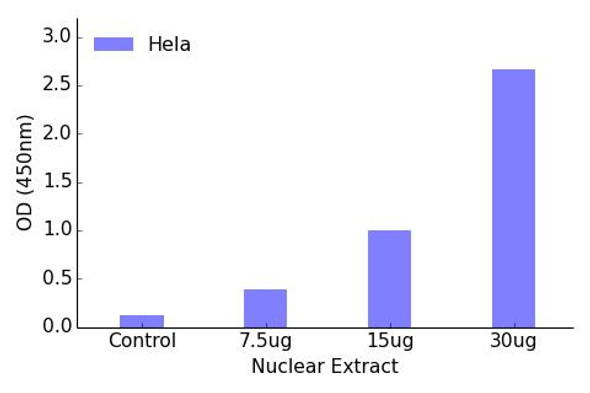Telomeric Repeat Binding Factor 1 Transcription Factor Activity Assay (TFAB00073)
- SKU:
- TFAB00073
- Product Type:
- ELISA Kit
- ELISA Type:
- Transcription Factor Assay
- Analytes:
- Telomeric Repeat Binding Factor 1
- Reactivity:
- Human
- Mouse
Description
Telomeric Repeat Binding Factor 1 Transcription Factor Activity Assay
The Telomeric Repeat Binding Factor 1 (TRF1) Transcription Factor Activity Assay Kit is a powerful tool for studying the function of TRF1 in cellular processes. This kit allows for the quantification of TRF1 transcription factor activity in a variety of sample types, including cell lysates and tissue homogenates.TRF1 is a key protein involved in the regulation of telomere length and stability, essential for maintaining genomic integrity and cell viability. Dysregulation of TRF1 has been linked to aging, cancer, and other diseases, making it a crucial target for research and drug development.
With high sensitivity and specificity, the TRF1 Transcription Factor Activity Assay Kit provides accurate and reproducible results, enabling researchers to further explore the role of TRF1 in various biological pathways. Whether studying telomere biology or investigating potential therapeutic strategies, this kit is a valuable resource for advancing scientific knowledge and unlocking new possibilities in the field of molecular biology.
| Product Name: | Telomeric Repeat Binding Factor 1 Transcription Factor Activity Assay |
| Product Code: | TFAB00073 |
| Target: | Telomeric Repeat Binding Factor 1 |
| Synonyms: | NIMA-interacting protein 2, TTAGGG repeat-binding factor 1, Telomeric protein Pin2/TRF1 |
| Reactivity: | Human, Mouse |
| Sample Types: | Nuclear or cell lysates |
The Assay Genie Telomeric Repeat Binding Factor 1 transcription factor activity assay allows for the detection and qualitative analysis of Telomeric Repeat Binding Factor 1 active transcription factors in eukaryotic nuclear or cell lysates.
Assay Genie ELISA kits are designed to significantly reduce experiment time and ensure sensitivity and flexibility for high-throughput screening.
| Assay Time: | 4.5 hours |
| Detection Method: | Colorimetric 450 nm |
| Size: | 12 x 8-Well Microstrips |
| Storage: | 4°C for 6 months |
| UniProt Protein Function: | TRF1: a telomeric repeat binding factor. Binds the telomeric double-stranded TTAGGG repeat and negatively regulates telomere length. Colocalizes with telomeric DNA in interphase and metaphase cells and is located at chromosome ends during metaphase. Involved in the regulation of the mitotic spindle. Expression is tightly regulated during the cell cycle; levels are low in G1 and S phase and increase during G2 phase and mitosis. Two splice variant isoforms have been described. |
| UniProt Protein Details: | Protein type:DNA-binding Chromosomal Location of Human Ortholog: 8q21.11 Cellular Component: nucleoplasm; chromosome, telomeric region; nuclear telomere cap complex; nuclear chromosome, telomeric region; cytoplasm; nucleolus; spindle; nucleus Molecular Function:protein binding; protein homodimerization activity; DNA binding; protein heterodimerization activity; microtubule binding; telomeric DNA binding; double-stranded telomeric DNA binding; chromatin binding; DNA bending activity Biological Process: response to drug; mitosis; positive regulation of mitosis; negative regulation of telomere maintenance via semi-conservative replication; positive regulation of apoptosis; positive regulation of microtubule polymerization; telomere maintenance via telomerase; positive regulation of mitotic cell cycle; negative regulation of telomerase activity; cell division; negative regulation of DNA replication; telomeric loop formation; mitotic cell cycle spindle assembly checkpoint; age-dependent telomere shortening; G2/M transition of mitotic cell cycle; negative regulation of telomere maintenance via telomerase; telomere maintenance; protein homooligomerization |
| NCBI Summary: | This gene encodes a telomere specific protein which is a component of the telomere nucleoprotein complex. This protein is present at telomeres throughout the cell cycle and functions as an inhibitor of telomerase, acting in cis to limit the elongation of individual chromosome ends. The protein structure contains a C-terminal Myb motif, a dimerization domain near its N-terminus and an acidic N-terminus. Two transcripts of this gene are alternatively spliced products. [provided by RefSeq, Jul 2008] |
| UniProt Code: | P54274 |
| NCBI GenInfo Identifier: | 206729904 |
| NCBI Gene ID: | 7013 |
| NCBI Accession: | P54274.3 |
| UniProt Secondary Accession: | P54274,Q15553, Q8NHT6, Q93029, A7XP29, |
| UniProt Related Accession: | P54274 |
| Molecular Weight: | 439 |
| NCBI Full Name: | Telomeric repeat-binding factor 1 |
| NCBI Synonym Full Names: | telomeric repeat binding factor (NIMA-interacting) 1 |
| NCBI Official Symbol: | TERF1 |
| NCBI Official Synonym Symbols: | TRF; PIN2; TRF1; TRBF1; t-TRF1; hTRF1-AS |
| NCBI Protein Information: | telomeric repeat-binding factor 1; NIMA-interacting protein 2; telomeric protein Pin2/TRF1; TTAGGG repeat-binding factor 1 |
| UniProt Protein Name: | Telomeric repeat-binding factor 1 |
| UniProt Synonym Protein Names: | NIMA-interacting protein 2; TTAGGG repeat-binding factor 1; Telomeric protein Pin2/TRF1 |
| Protein Family: | Telomeric repeat-binding factor |
| UniProt Gene Name: | TERF1 |
| UniProt Entry Name: | TERF1_HUMAN |





